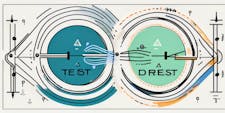What Is the SAT? – Everything You Need to Know in 2024
Updated March 7, 2024
- The Purpose of the SAT: Understanding Its Importance
- What Sections Are on the SAT Exam?
empty
empty
empty
- How to Prepare for the SAT
- SAT Example Questions
empty
empty
empty
empty
- How Is the SAT Scored?
empty
- SAT Examination Registration: How to Register for The SAT Exam
- What to Bring to the SAT Exam?
- What Does the SAT Test Cost?
empty
- Frequently Asked Questions
- Final Thoughts
The SAT, or Scholastic Assessment Test, is a standardized exam widely used for college admissions in the United States.
It measures a student's knowledge and skills in key areas such as reading, writing and math.
This article covers the SAT, including its purpose, structure, registration process, costs, preparation tips, and frequently asked questions.
The Purpose of the SAT: Understanding Its Importance
Colleges use the SAT to assess students' readiness for higher education as part of the college admissions process. It measures a student's critical thinking, problem-solving and analytical reasoning abilities.
While SAT scores are not the sole determinant of college admission, they provide admissions officers with valuable insight into a student's abilities and potential for success.
Therefore, preparing and performing well on the SAT can increase your chances of acceptance into your desired college or university.
What Sections Are on the SAT Exam?
The SAT consists of four main sections:
- Reading
- Writing and language
- Math (with a calculator)
- Math (no calculator)
Each section is carefully crafted to evaluate different skills and abilities essential for college success.
Reading
The reading section assesses your ability to understand and analyze written passages.
It includes various reading comprehension questions that test your ability to interpret and draw conclusions from the given texts.
Writing and Language
The writing and language section evaluates your writing skills, including grammar and usage. It presents you with passages that contain errors or areas for improvement.
Your task is to identify and correct these errors, demonstrating your command of the English language and your ability to communicate ideas effectively.
Math Sections
The math sections test your mathematical knowledge and problem-solving abilities. The section with a calculator allows you to use a calculator to solve complex math problems.
In contrast, the section without a calculator assesses your problem-solving ability using mental math and logical reasoning.
These sections cover various topics, including:
- Algebra
- Geometry
- Statistics
- Data analysis
Each section is timed, and students must complete the test within the given time limits. Time management is crucial to success on the SAT, as you must allocate enough time to each section while ensuring you have enough time to answer all the SAT questions.
The reading section allows 65 minutes, the writing and language section allows 35 minutes, and each math section allows 25 minutes.
Additionally, there is an optional essay section, which allows an additional 50 minutes. This section requires you to analyze and evaluate an argument presented in a passage and express your perspective.

How to Prepare for the SAT
Preparing for the SAT involves a variety of strategies and resources.
Many students enroll in SAT prep courses or hire tutors to help them navigate the test's format and content.
These courses often include practice tests, study materials, and personalized instruction to help students improve their performance.
Furthermore, numerous online resources, such as SAT practice websites, study guides and interactive tools, are available to students. These resources allow students to familiarize themselves with the test's structure, practice different question types, and track their progress.
The SAT is a timed test, with specific sections dedicated to reading, writing and language, math (with and without a calculator) and an optional essay. Each section is designed to assess different skills and knowledge areas.
On test day, students must arrive early and bring several essential items, including their admission ticket, identification and approved calculators.
After completing the SAT, students can choose to send their scores to colleges and universities of their choice.
It is important to note that some institutions may require or recommend SAT subject tests in addition to the general SAT.
These subject tests allow students to showcase their knowledge in specific areas, such as mathematics, science, literature, or foreign languages.
SAT Example Questions
To give you a better understanding of what to expect on the SAT, let's take a look at some example SAT questions from each section:
Reading Section
In the wake of recent technological advancements, particularly in the realm of artificial intelligence, society finds itself grappling with ethical dilemmas previously unimagined. As machines become increasingly autonomous, questions arise regarding their impact on employment, privacy, and human rights. These issues necessitate careful consideration and proactive measures to ensure that technological progress aligns with societal values and aspirations.
Based on the information provided in the passage, what is the main idea?
a) The author's personal experience with a particular topic
b) The historical context of the events described
c) The scientific principles underlying the phenomenon
d) The social implications of the issue discussed
Choose the word or phrase that best completes the sentence and maintains the passage’s tone.
Despite the challenges they faced, the team members __________ persevered and achieved their goal.
a) reluctantly
b) enthusiastically
c) haphazardly
d) indifferently
Find the value of :
a)
b)
c)
d)
Simplify the expression:
a)
b)
c)
d)
How Is the SAT Scored?
Scoring for the SAT is based on a scale of 400 to 1,600, with 1,600 being the highest possible score. Each section is scored individually, and the final score is a sum of the section scores.
The essay section is scored separately on a scale of six to 24.
The scoring process considers the number of correct answers and the difficulty level of the questions answered correctly.
It is important to note that there is no penalty for guessing on the SAT; therefore, it is beneficial to answer every question, even if you are unsure.
What Is a Perfect SAT Score?
A perfect SAT score is 1,600. This is achieved by scoring the maximum possible 800 points in the evidence-based reading and writing section and the maths section.
The optional Essay, if taken, is scored separately on a scale of six to 24, but it does not contribute to the overall SAT score of 1,600.
SAT Examination Registration: How to Register for The SAT Exam
Registering for the SAT is a straightforward process on the user-friendly College Board website. Follow a few simple steps to secure your exam spot and start preparing for this academic milestone.
First, create an account, your gateway to SAT resources, practice tests, and personalized study plans.
You must provide the necessary personal information, such as your name, address and contact details. Upload a suitable photo following the College Board's guidelines for identification.
This photo will be printed on your admission ticket and is crucial for identity verification on test day.
After creating your account, pick a test date and a nearby test center.
After completing the registration process, you will be prompted to pay the registration fee.
The fee may vary depending on your location; however, it is important to note that the College Board offers financial aid options for eligible students who may need help to afford the full fee. These financial aid options ensure that all students have an equal opportunity to showcase their academic abilities regardless of their financial circumstances.
After confirming SAT exam registration and payment, you'll get an admission ticket by email with essential details like test date and location.
What to Bring to the SAT Exam?
When taking the SAT, it's important to bring the following items:
- Admission Ticket – Print your admission ticket and bring it with you to the test center
- Acceptable Photo ID – A valid photo ID, such as a driver's license or passport, is required for admission
- No. 2 Pencils – Bring several sharpened No. 2 pencils with erasers. Mechanical pencils are not allowed
- Approved Calculator – If the test includes a math section, bring an approved calculator. Check the College Board website for the list of approved calculators
- Snacks – Bring a snack and a drink (in a clear container) for the breaks. Make sure they are in accordance with the test center regulations
- Watch – A watch to keep track of time, as some test centers may not have visible clocks
- Layers of Clothing – Dress in layers to ensure you're comfortable, as temperatures in the testing room can vary
It's essential to check the official SAT website and your admission ticket for any specific instructions or changes to the required items.
Additionally, avoid bringing items like electronic devices, notes, or unauthorized aids, as these are not allowed during the test.
What Does the SAT Test Cost?
The SAT cost varies by location and whether the optional essay section is chosen. As of 2021, the basic registration fee is $52 without the essay and $68 with it.
Additional fees apply for late registration, changing test details and other services.
Although the registration fee might seem substantial, it's essential to consider the potential return on investment.
A high SAT score can lead to scholarships and grants, as many colleges offer merit-based aid for exceptional scores.
Moreover, the SAT invests in a student's future, fostering skills like critical thinking and time management. These skills contribute not only to college admissions but also to success in higher education and beyond.
Fee Waivers
The College Board administers the SAT and recognizes the financial strain of standardized testing on students and families.
To alleviate this burden, they provide fee waivers to eligible students, covering the SAT registration fee and additional services like sending score reports.
Eligibility is determined by factors such as family income, participation in government assistance programs, or enrollment in a free or reduced-price lunch program.
Qualifying students can take the SAT for free, removing the financial barrier associated with testing fees.
Frequently Asked Questions
SAT stands for Scholastic Assessment Test.
The SAT is a standardized test for US college admissions, assessing students' readiness with sections on math, reading and writing skills.
It gauges critical thinking and analytical abilities. While just one part of admissions decisions, many US colleges consider SAT scores alongside GPA, extracurriculars, essays and recommendations.
A score of 1,200 on the SAT is considered above average. While it may vary based on individual circumstances and target colleges, this score reflects solid subject understanding.
Admissions officers also consider other factors such as GPA, extracurriculars, essays and recommendations for a holistic evaluation in the college admissions process.
The difficulty of the SAT varies for individuals. It assesses critical thinking, math, and reading skills. Adequate preparation, practice and familiarity with the test format can help.
Many resources, such as study guides and practice tests, are available to support test-takers in navigating the SAT's challenges and optimizing their performance.
A score of 1,100 on the SAT is below the national average but may be acceptable for some colleges. However, what qualifies as a "good" score depends on individual goals and target institutions. Admissions officers consider a holistic view, including GPA, extracurriculars, essays and recommendations, in the evaluation process.
Yes, a score of 800 on the SAT is the highest possible and is considered an excellent achievement. It reflects exceptional proficiency in the assessed subjects. However, other factors like GPA, extracurriculars, essays and recommendations also contribute to a holistic evaluation in the college admissions process.
A score of 1,300 on the SAT is above the national average and generally considered a good score. It reflects strong subject understanding and can be competitive for many colleges.
However, admissions decisions are holistic, considering factors such as GPA, extracurriculars, essays and recommendations in the evaluation process.
Harvard University does not have a strict SAT score requirement, and its admissions process is holistic. However, competitive applicants often have SAT scores well above the national average.
Typically, successful candidates score in the high 1,500s or even close to a perfect 1,600, along with outstanding achievements in other areas.
Final Thoughts
The SAT is an important stepping stone for college admissions and can significantly impact your educational journey.
By understanding the purpose, structure, and preparation strategies for this exam, you can approach it with confidence and maximize your chances of achieving a competitive score.
Remember that while the SAT is significant, it is just one aspect of your college application. Combine your test performance with strong academics, extracurricular involvement and a compelling personal statement to present a well-rounded application to colleges and universities.






